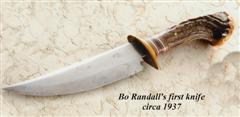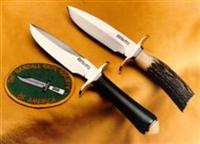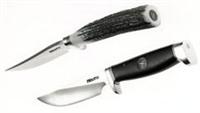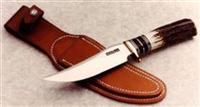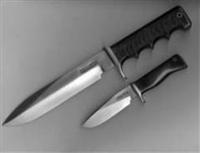Thanks, Bernie. Here goes:
Knife:
1. Blade grind: Could be anywhere in the 50's. There was some variation in the depth and radii of the choil during this decade, but I think it had more to do with who was doing the grinding at the time the blade was ground. This doesn't give you much to go on.
2. The stamp is small as it should be on a Model 7.
3. Hilt: really doesn't tell you anything.
4. Spacers (7): Only tells you that it was likely made on or before ~'72.
5. (Stag) handle: No pin would lead one to believe the knife was made on or after ~'58. However, there have been a few stag handled knives for sure made prior to '58 (and in fact going back in to the 40's) that do surface without a pin. I don't think anyone is ever going to know the reason(s) why: Overlooked by the assembler or ordered that way by the customer or ?
Sheath:
1. No guarantee it was the original shipped with the knife but we can make a reasonable assumption that is was if there are no era conflicts with the knife.
2. You would expect a very early 50's sheath would have a wider stone pocket flap than this one.
3. It has a horizontal keeper so it's probably not later than ~ '57.
4. It has a Roman numeral "I" on the back, which I haven't seen on a sheath later than ~'55.
Stone:
1. Again for the sake of argument let's assume it's original to the knife and sheath. There is no printing showing so I don't know if it's a "Carborundum No. 74 SIC" or an Norton with the oval label or even a later Combination Crystolon.
Bottom line is that all the evidence falls into a mid to late 50's bracket as I see it. Crutch or whomever may have differing opinions. If I'm wrong I will have learned something and that's a good thing.
By the way......great little knife :-)


